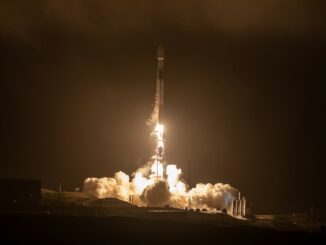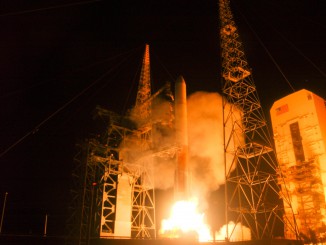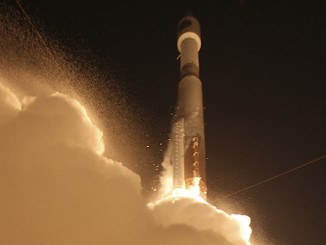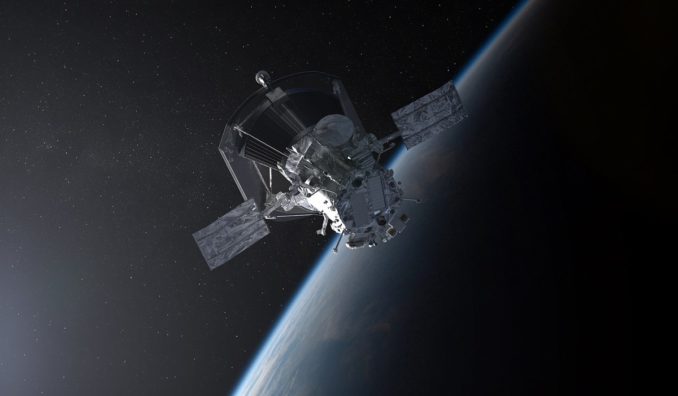
Space missions dispatched into the solar system often have journeys lasting years before reaching a scientific payoff, but NASA’s Parker Solar Probe launched last weekend on a speedy departure from planet Earth is already getting ready to sweep closer to the sun than any spacecraft in history during a flyby later this year.
The armored spacecraft lifted off Sunday, Aug. 12, from Cape Canaveral on top of a United Launch Alliance Delta 4-Heavy rocket, one of the most powerful launchers in the world.
Sometimes used to launch satellites as big as a school bus, the Delta 4-Heavy and a kick motor shot Parker Solar Probe — the size of a small car — into space with enough speed to reach Venus in just 52 days, the fastest-ever journey to from Earth to another planet.
Parker Solar Probe will slingshot past Venus, with the craft’s closest approach expected Oct. 3 at 4:44 a.m. EDT (0844 GMT) to redirect its orbit closer to the sun. The gravity assist flyby will set up the solar probe for its first perihelion — or close approach to the sun — on Nov. 5 at 10:27 p.m. EST (0327 GMT on Nov. 6).
Those dates changed slightly after launch delays pushed back Parker Solar Probe’s liftoff from an original target date of July 31.
In November, the spacecraft will reach a point in its elliptical, oval-shaped orbit roughly 15 million miles (24.1 million kilometers) from the sun’s surface, breaking a record set by the U.S.-German Helios 2 mission, which passed as close as 27 million miles (43.4 million kilometers) from the sun in April 1976.
Parker Solar Probe carries four instrument packages to measure magnetic and electric fields, detect, count and characterize particles in the solar wind and inside the sun’s atmosphere, and take white light images inside the sun’s corona.
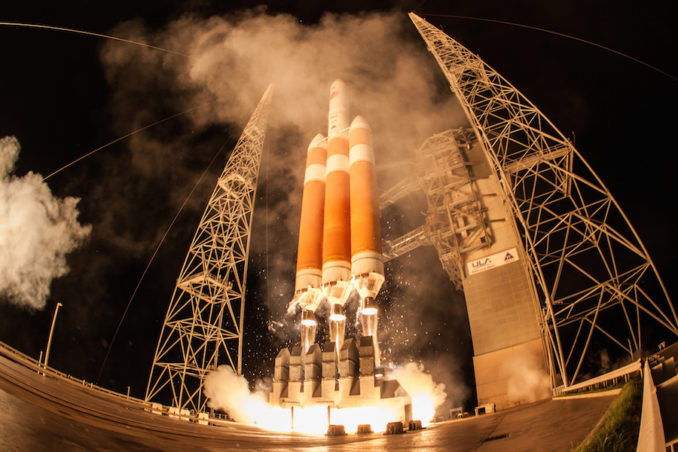
The $1.5 billion mission has been on NASA’s to-do list for six decades, since the agency’s formation and the first prediction of the solar wind by Eugene Parker, a University of Chicago physicist whose hypotheses about the supersonic stream of particles emanating from the sun were later confirmed by early space missions.
NASA named the solar probe for Parker last year, the first time the agency has named a science mission for a living person. Parker, 91, traveled to the Kennedy Space Center for the Aug. 12 launch.
The 1,424-pound (646-kilogram) spacecraft separated from a kick stage that launched atop the Delta 4-Heavy less than 45 minutes after liftoff last Sunday. A few minutes later, ground controllers confirmed the probe extended its two solar panels to begin generating electricity.
Parker Solar Probe’s high-gain antenna, designed to downlink science data to Earth, was released from its launch locks Aug. 13. The mission’s autonomous control system, which uses fast-spinning reaction wheels and thrusters, has also been activated as planned, according to an update released Friday by NASA and the Johns Hopkins University Applied Physics Laboratory in Laurel, Maryland, which built the spacecraft.
The spacecraft also powered up the first of four instrument suites beginning Aug. 13. The spacecraft released clamps holding four of five antennas comprising the FIELDS instrument. The roughly 6-foot-long (2-meter) antennas will be deployed around 30 days after launch to stick out from behind the probe’s heat shield, exposing the sensors to the harsh environment of the corona for measurements of electric and magnetic fields, plasma waves, and interplanetary radio emissions.
Parker Solar Probe also extended its magnetometer boom, which holds three magnetometers and a smaller, fifth antenna that is part of the FIELDS instrument suite.
“Parker Solar Probe is operating as designed, and we are progressing through our commissioning activities,” Andy Driesman, the mission’s project manager at APL. “The team – which is monitoring the spacecraft 24 hours a day, seven days a week – is observing nominal data from the systems as we bring them online and prepare Parker Solar Probe for its upcoming initial Venus gravity assist.”
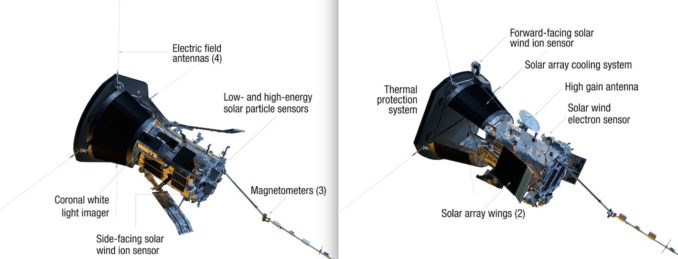
Scientists will have to wait more than six years for Parker Solar Probe’s closest encounter with the sun, but the mission could produce results well before then.
“In our very first flyby of the corona (in November), we get to a little more than 15 million miles from the sun’s surface,” said Nicola Fox, Parker Solar Probe’s project scientist at APL. “We’re already in a … very, very interesting coronal area. In fact, one of the key things about our early orbits is we’re actually just sort of at this sweet spot.
“As we’re rotating around the sun, the sun is rotating at the same time, the same speed,” Fox said. “If you think about it in that frame, the spacecraft is staying over the same area of the sun for many, many days, allowing us to do some incredible science on our very first flyby.”
The first perihelion in November will also return data to help scientists fully calibrate the spacecraft’s science instruments.
Six more Venus flybys will spiral Parker Solar Probe ever-closer to the sun, redirecting the craft’s trajectory toward its closest encounter with the sun at a range of 3.83 million miles (6.16 million kilometers) in 2024, roughly 4 percent the distance of the sun from Earth.
At that distance, the sun’s gravity will whip Parker Solar Probe around in its orbit at a velocity of up to 430,000 mph (nearly 700,000 kilometers per hour), fast enough to travel from Philadelphia to Washington, D.C., in one second.
Reaching such immense speeds requires — perhaps counterintuitively — that Parker Solar Probe to first slow down, allowing solar gravity to pull it closer to the sun.
“Venus is very important to us,” Fox said. “We actually use Venus to do gravity assists. Not like other missions you’ve heard about that take energy from the planet to speed up, we actually generously give energy to Venus, and we use Venus to slow us down just a little bit, really to focus our orbit, almost like doing a little handbrake turn and focusing us in towards the sun. We will do 24 petal orbits, coming very close to the sun on one side, going out around the orbit of Venus on the other.”
Parker Solar Probe will fly through the corona, a super-heated envelope of plasma surrounding the sun where temperatures soar to millions of degrees. The temperature at the surface of the sun is hundreds of times cooler, but still a scorching 10,000 degrees Fahrenheit (6,000 degrees Celsius).
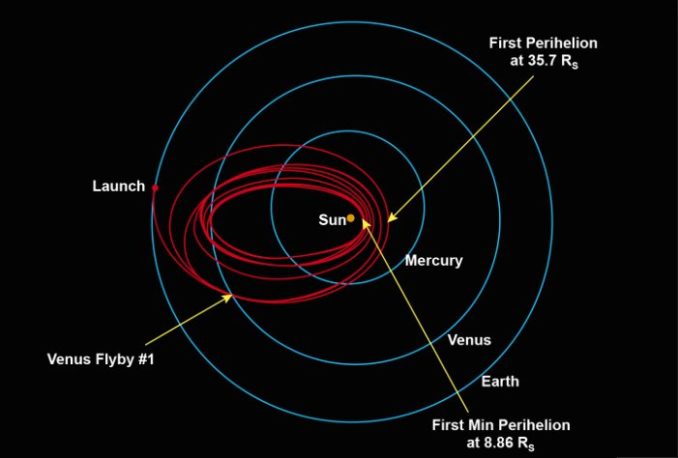
The corona is also thought by scientists to be the origin of the solar wind, a flow of charged particles flowing away from the sun in every direction, influencing the entire solar system and driving space weather.
“How is the solar wind accelerated up to millions of miles per hour very quickly in the solar corona? The work that Dr. Parker has laid out is the foundational work for understanding this process, and this is one of the primary goals of the Parker Solar Probe,” said Alex Young, associate director for science in the heliophysics division at NASA’s Goddard Space Flight Center in Maryland.
“Why does this all matter? We’re living in this dynamic sun’s atmosphere. We’re living in the solar wind streaming by the Earth, streaming by other planets,” Young said. “We see the beautiful results with the aurora, but this also creates an incredibly dynamic environment that impacts our technology, makes the environment hostile for astronauts, and in the most extreme cases, can even impact technology and power grids here on Earth.”
A heat shield made of two carbon-carbon panels sandwiching a carbon foam core will protect most of the spacecraft from the blistering conditions in the corona. The heat shield’s sun-facing side also has a sprayed-on white coating to reflect as much of the sun’s heat as possible.
“We will be orbiting through the 3-million-degree plasma region,” Fox said. “That sounds really hot, but the plasma there is not very dense. If you imagine turning your oven on to 400 degrees and letting it heat up, you could put your hand inside that oven. It won’t burn you unless you touch something, so there’s a difference between temperature and heat.
“There aren’t that many particles around, so the actual amount that couples into the front side of our heat shield means that the front side is about 2,500 degrees Fahrenheit, or 1,400 degrees Centigrade (Celsius),” Fox said.
Behind the heat shield, or thermal protection system, the main body of the spacecraft will be warmed a little hotter than room temperature, but still within engineering tolerances for crucial parts like the probe’s computer and propulsion system.
But some parts of the spacecraft, such as its science instrumentation and solar panels, will be exposed to the hot corona.
“We are very happy that we are well protected,” Fox said. “We have a full suite of instruments to make the measurements that are so key and important for us to be able to close the science. So we have instruments that measure all of the magnetic and electric fields, they’re looking for plasma waves, the very high-energy particles, and we also have a while light imager that is taking pictures of basically what we’re about to plow through. So we have a full suite of instruments.”
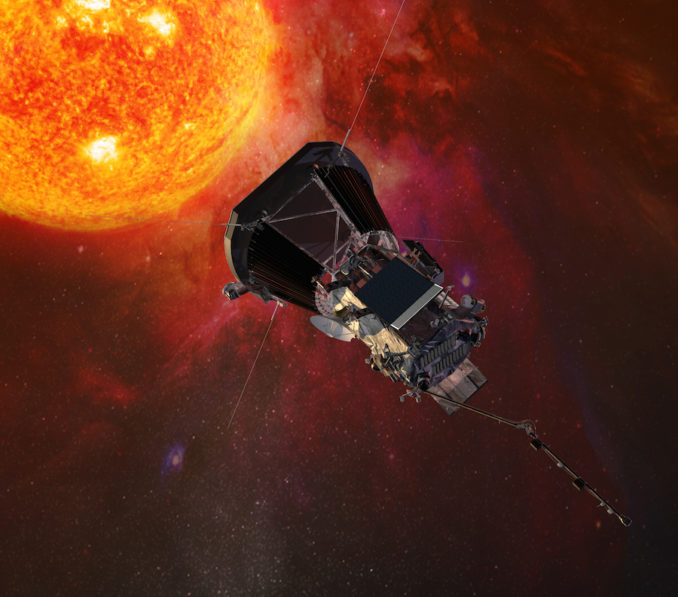
Engineers designed a cooling system using five liters of water to keep the craft’s sensitive solar cells from overheating.
“Solar cells need to stay cool,” Fox said. “They don’t like to overheat and if they do, they don’t work. So we (had) to find a way to cool our panels as we are making these cuts through the corona.”
When Parker Solar Probe is closest to the sun, its on-board computer will automatically adjust its pointing, the performance of the cooling system, and other factors to keep the spacecraft safe. Ground controllers will not be able to uplink commands in real-time as the spacecraft transits through the corona.
“She is the most independent spacecraft, she’s highly, highly autonomous,” Fox said. “She has to look after herself when she’s in this coronal region. There is no person in the loop, she is fully capable of figuring out if there’s an anomaly how to rectify it. It takes light eight minutes to get from the sun to the Earth, we don’t have time for her to send a signal so we can think about it and send it back. She has to be able to look after herself.”
Parker Solar Probe will radio a beacon signal back to Earth as it flies through the corona, but ground commands and high-speed data downlinks will have to wait for times when the spacecraft is farther from the sun.
“These are kind of the big technology leaps we’ve had to make,” Fox said. “That is why we’ve had to wait 60 years for this mission.”
Email the author.
Follow Stephen Clark on Twitter: @StephenClark1.

